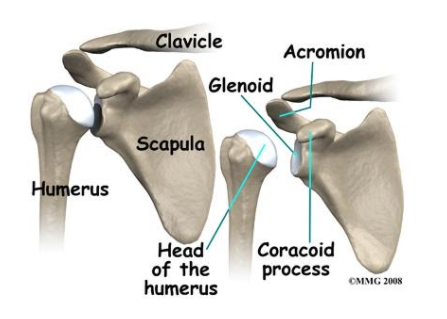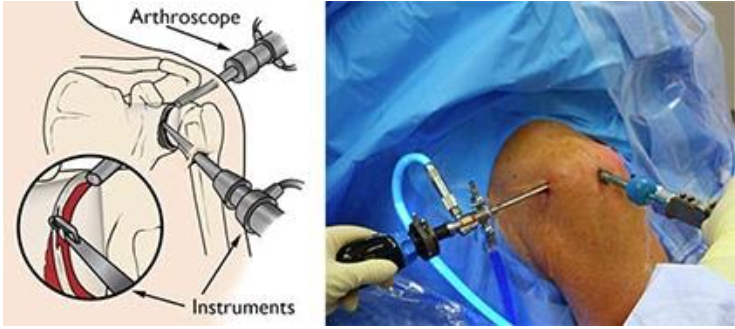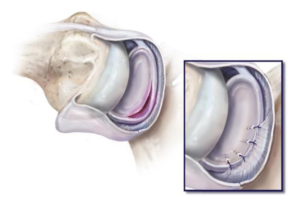SHOULDER DISLOCATION
- Home
- Shoulder Dislocation
The shoulder joint is a ball-and-socket joint. The socket is a small and shallow part of the shoulder blade (glenoid) and the ball is around and big structure formed by the upper end (head) of the arm bone (humerus). This big ball and small socket make the shoulder not only the most mobile joint in the body but also inherently unstable and the most dislocated joint in the body.
The humeral head is stabilized on the glenoid by virtue of static (Bone, ligament, capsule and labrum) and dynamic stabilizers (muscles). When the humerus head moves out of its socket in the shoulder joint, the shoulder is said to be dislocated. Shoulder subluxation occurs when the top of the humerus is only partially displaced and not totally out of its socket. The labrum is a rim of thick rubber-like tissue all around the edge of the glenoid. This helps in gripping the head in the socket. This does not allow the shoulder to come out of the socket and when it gets detached the shoulder comes out. In most of the cases healing of this, the labrum at the native place and decides the outcome of dislocation.


The most common reason for a shoulder to dislocate is an injury such as fall on an out-stretched hand and almost all shoulder dislocations are related to trauma like arm pull/twist, direct injury to the shoulder, seizure, electric shock, Occasionally, the dislocation occurs after ordinarily harmless motions, such as raising an arm or rolling over in bed. Young adults, people with ligament laxity and those with bony defects are prone to re-dislocations.

Shoulder dislocations (especially 1st or initial) are severely painful. It distorts shoulder contour and limits shoulder motion. One can experience the pop of the ball coming out of its socket. Patients usually have to support the arm to avoid movement and pain.
Dislocations usually warrant emergency reduction of the ball into the socket to prevent permanent damage to the shoulder. The doctor will examine both shoulders for comparison. The doctor will check for swelling, abrasions, bruising and pain when you move. He will palpate for empty sockets and abnormal position of the ball and limited motion at the shoulder joint. He will check for a pulse at your wrist, your muscle strength and for sensations in the arm particularly the numbness on the outside of your upper arm. This sensory loss is a sign of injury to the axillary nerve, which is vulnerable to injury in a shoulder dislocation.
Once the shoulder joint is reduced patient feels immediate relief. You will be ordered an x-ray before and after reduction to confirm the diagnosis as well as to evaluate associated injuries like fractures.
When the shoulder dislocates more than 2-3 times, we call it recurrent dislocation which warrants further evaluation with higher imaging like MRI and CT scans (can be done after 1st dislocation also). These usually show labral lesion called as Bankart lesion which has not healed or has healed in an abnormal position. Sometimes bone loss may be apparent which makes the shoulder more vulnerable to re-dislocation.

If you are an athlete or workout enthusiast or involve in activities that need extreme motion of your shoulder then you should learn appropriate techniques to achieve muscle balance and strength in your shoulder. A professional trainer might be able to help to achieve it in a better way. Once one has had a dislocated shoulder, rest to the shoulder is essential to allow adequate healing. You should undergo a shoulder range of motion and strengthening exercises recommended by your doctor or physical therapist to get back to pre-injury status and prevent re-dislocation. Elderly people should use stick or support while walking to avoid fall and injury to the shoulder.

Acute shoulder dislocation and conservative treatment:

1. Arthroscopic Shoulder Surgery: It is a minimally invasive procedure in which a joint is reached with the use of a small telescope (arthroscope) and surgical tools inserted through small incisions into the shoulder joint. Tiny suture anchors are used to reattaching the torn labrum to its native place. Tightening of torn or stretched tendons or ligaments is also done.

2. Open Shoulder Surgery: in some situations where arthroscopy cannot be used or the surgeon expects bony injury and bone loss the procedure can be performed through an open conventional approach where the joint is open through a large incision on the shoulder. Although the results of the open and arthroscopic procedures are the same recovery is rapid in an arthroscopic procedures. Open surgeries are also helpful in doing additional procedures like bone grafting.


LIFE IS MOBILITY & MOBILITY IS LIFE
Copyright ©2020 . All Rights Reserved Designed by NexEdge